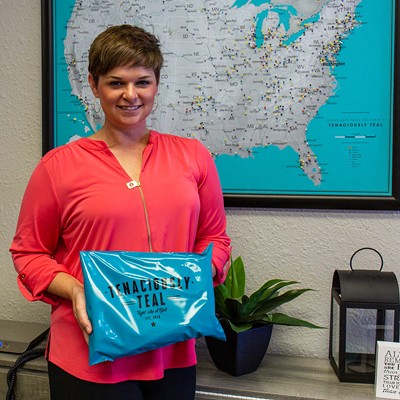Variety Care, a federally recognized community health center, provides affordable and accessible health care at 10 locations statewide, including seven in the Oklahoma City metro. Services include medical, dental, vision and behavioral care for all ages.
According to Lou Carmichael, executive director, the average annual cost per capita for health care in the U.S. is about $9,000, while Variety Care’s annual cost per patient is less than $500.
“If we all had access to primary care,” she said, “then outcomes would be totally different.”
right Mike Dover and Lou Carmichael look at renovations at the Lafayette Inasmuch Foundation Wellness and Pediatric Center.
The organization’s fundraising arm, Variety Care Foundation, currently is spearheading an $18 million capital campaign to fund expansion projects at its two largest sites, plus construction of a new administration building. The campaign needs less than $1 million to reach its goal.
The capital projects will help the organization serve 65,000 Oklahomans annually by 2013, according to Mike Dover, foundation president.
About 90 percent of Variety Care’s clients live in the metro, and space is at a premium at Straka Family Health Center and Lafayette Center, both located in south Oklahoma City.
“We can’t see any more patients with the existing space,” Carmichael said. “If you call to try to make an appointment right now, you’d have a hard time getting in.”
If we all had access to primary care, outcomes would be different.
—Lou Carmichael
In November 2009, Variety Care received a $12 million federal grant. The foundation has worked since to raise the final $6 million locally, Dover said. The Inasmuch Foundation gave $2 million. The Lafayette facility, a former Oklahoma City elementary school, will be renamed the Lafayette Inasmuch Foundation Wellness and Pediatric Center.
Chesapeake Energy gave $500,000, and Devon Energy gave $250,000. More donations have come in, and a donation box has been set up at the Lafayette facility.
About 60 percent of Variety Care’s patients have some form of insurance, typically Medicare, Medicaid or SoonerCare, Carmichael said, with the remaining 40 percent completely uninsured. Patients pay on a sliding fee schedule.
“It’s affordable, but it’s not free,” Carmichael said. “We find that gives the patient an investment in their health care.”
Photo by Mark Hancock











